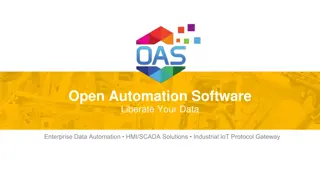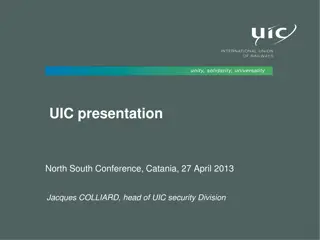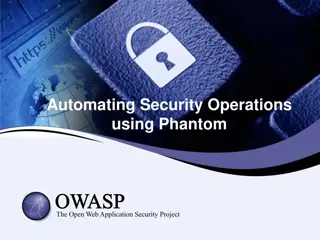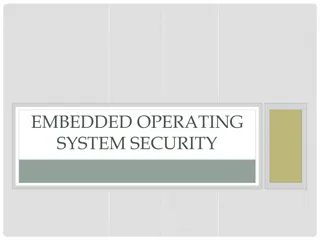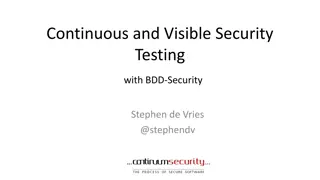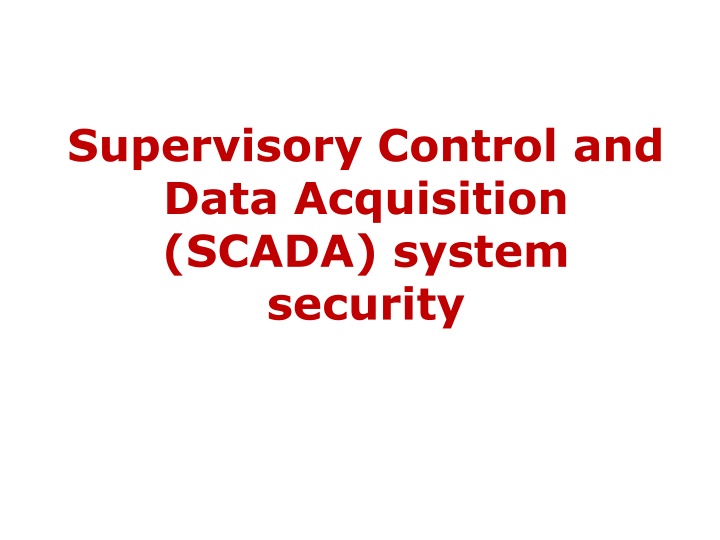
SCADA System Security
A comprehensive overview of Supervisory Control and Data Acquisition (SCADA) systems, focusing on their importance in real-time industrial process control, potential vulnerabilities to cyber-attacks, historical incidents, and key components such as Programmable Logic Controllers (PLC). Explore the evolution of SCADA systems, their architecture, network segments, and the use of ladder logic for automated control. Understand the critical role SCADA systems play in monitoring and managing remote industrial equipment in various sectors. Stay informed about SCADA security challenges and advancements in safeguarding these vital components of critical infrastructures.
Download Presentation

Please find below an Image/Link to download the presentation.
The content on the website is provided AS IS for your information and personal use only. It may not be sold, licensed, or shared on other websites without obtaining consent from the author. If you encounter any issues during the download, it is possible that the publisher has removed the file from their server.
You are allowed to download the files provided on this website for personal or commercial use, subject to the condition that they are used lawfully. All files are the property of their respective owners.
The content on the website is provided AS IS for your information and personal use only. It may not be sold, licensed, or shared on other websites without obtaining consent from the author.
E N D
Presentation Transcript
Supervisory Control and Data Acquisition (SCADA) system security
Reading Nicholson et al. 2012. SCADA security in the light of Cyber-Warfare. 2012. Computers & Security, Volume 31, Issue 4, June 2012., http://www.sciencedirect.com/science/article/pii/S0167404812000429 S. McLaughlin and P. McDaniel. 2012. SABOT: specification-based payload generation for programmable logic controllers. In Proceedings of the 2012 ACM conference on Computer and communications security (CCS '12). ACM, New York, NY, USA, 439-449. http://dl.acm.org/citation.cfm?id=2382244
Supervisory Control And Data Acquisition (SCADA) Real time industrial process control systems to monitor and control remote or local industrial equipment Vital components of most nation s critical infrastructures Risk of deliberate attacks!
SCADA Systems 1990: mainframe computer supervision 1970: general purpose operating systems 1990: off the shelf computing Highly distributed with central control Field devices control local operations
SCADA Components Corporate network segment Typical IT network SCADA network segment Servers and workstations to interact with field devices Human-machine interfaces Operators Software validation Field devices segment Programmable Logic Controllers (PLC) Remote Terminal Units (RTU) Intelligent Electronic Devices (IED)
Process Control System (PCS) Safety System Source: www.clcert.cl/seminario/ US-CERT_Chile_2007-FINALv2.ppt
SCADA and PLC Overview Ladder logic overview What is ladder logic? Why is it the programming language of choice for automated control systems?
SCADA Incidents Flaws and mistakes 1986: Chernobyl Soviet Union 56 direct death, 4000 related cancer death 1999: Whatcom Creeks Washington US pipeline rupture Spilling 237,000 gallons of gasoline that ignited, 3 human life and all aquatic life 2003: North East Blackout of US and Canada Affected 55 million people, 11 death 2011: Fukushima Daiichi nuclear disaster Japan Loss of human lives, cancer, psychological distress
Attackers Script kiddies Hackers Organized crime Disgruntled insiders Competitors Terrorists Hactivists Eco-terrorists Nation states
SCADA Security Perimeter Protection Firewall, IPS, VPN, AV Host IDS, Host AV DMZ Interior Security Firewall, IDS, VPN, AV Host IDS, Host AV NAC Scanning Monitoring Management
Programmable Logic Controllers Computer based solid state devices Control industrial equipment and processes Regulate process flow Automobile assembly line Have physical effect
Related Work Security working groups for the various infrastructure sectors of water, electricity and natural gas US Departments of Energy and Homeland Security: investigation into the problem domain of SCADA systems
Related Work Traditionally vendors focused on functionality and used physical security measures An attempt was made to try to match physical security mechanisms online Vulnerabilities: Classification by affected technology Classification by error or mistakes Classification by enabled attack scenario
SCADA and PLC Security Increased risk to SCADA systems, introduces another element of risk to the PLC and all of the control elements PLC s dictate the functionality of the process PLC programming software and SCADA control software can be housed on the same machine The newest PLC hardware devices allow for direct access to the PLC through the network
SCADA and PLC Security SCADA System Control Flow
SCADA and PLC Security Prior to the Stuxnet attack (2010): it was believed any cyber attack (targeted or not) would be detected by IT security technologies Need: standard be implemented that would allow both novice and experience PLC programmers to verify and validate their code against a set of rules. How do we show that PLC code and be verified and validated to assist in the mitigation of current and future security risks (errors)?
Application of Touchpoints External Review 3. Penetration Testing 1. Code Review (Tools) 6. Security Requirements 4. Risk-Based Security Tests 2. Risk Analysis 7. Security Operations 5. Abuse cases 2. Risk Analysis Requirement and Use cases Architecture and Design Tests and Test Results Feedback from the Field Test Plans Code 19
PLC Security Framework (PLC-SF) Static Analysis Tool: Compiler Workflow
PLC Security Framework (PLC-SF) Components: PLC Security Vulnerability Taxonomy Design Patterns Severity Chart Engines: Taxonomy Engine Design Pattern Engine Severity Engine
Vulnerabilities Analysis Attack Severity Analysis Building the Vulnerability Taxonomy Potential Exploitation of Coding Errors Modeling PLC Vulnerabilities
Attack Severity Analysis Severity Chart Each row of the Severity Chart represents a different level of security risk, within the PLC error found The error levels range from A D, with A being the most severe and D being the least severe Each column represents the effects which can occur in the PLC and those that can occur in the SCADA system PC
Attack Severity Analysis Severity Chart Severity A Effects in PLC PLC Code will not perform the desired tasks Effects in SCADA Will not allow for remote operation of the process The process could experience intermittent process failure Data shown on the SCADA screen is most likely false B Serious hindrance to the process C Adversely effects PLC code performance. A minimal cost effect to the project, but a quick fix is possible Effects the credibility of the system, but the PLC code is operable D Incorrect data could be randomly reported, cause a lack of confidence in the system
Attack Severity Analysis Severity Chart Severity Classifications: Severity Level A: Could potentially cause all, or part, of a critical process to become non- functional. Severity Level B: Could potentially cause all, or part, of a critical process to perform erratically. Severity Level C: Denote a quick fixes Severity Level D: Provide false or misrepresented information to the SCADA terminal.
Building the Vulnerability Taxonomy Purpose: To aid the process of detecting these vulnerabilities in the PLC code Intended to be extensible Created such that it can be expanded as: Future versions of PLC s are created New errors are found
Building the Vulnerability Taxonomy Vulnerability Taxonomy: Software Based (Virtual) Errors
Potential Exploitation of Coding Errors Error Type Taxonomy Classification Duplicate Objects Installed Malicious User Opportunity Alterations of one or more of the duplicate objects Pre-loaded variables allow for an immediate entry point into the system Installation of jump to subroutine command which would alter the intended file to file interaction Immediate entry point to logic level components such as timers, counters, and arithmetic operations Would allow for a placement point for a system bypass Process Critical / Nuisance Process Critical Unused Objects Process Critical Scope and Linkage Errors Process Critical Logic Errors Process Critical / Nuisance Hidden Jumpers
SABOT Impact on PLC Attacks Software-based exploits of SCADA Understanding of industrial control systems Specification-based Attacks againts Boolean Operations and Timers (SABOT)
SABOT Attack Encode understanding of the plant s behavior into a specification SABOT downloads existing control logic from the victim SABOT finds mapping between the specific devices and the variables within the control logic SABOT generates malicious PLC payload








